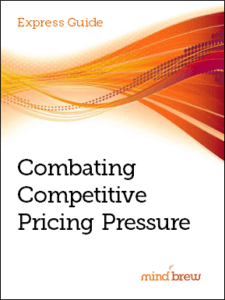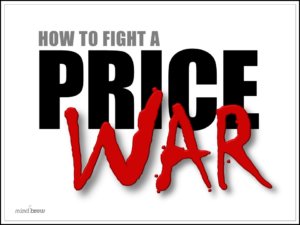It’s undeniably true that some businesses are currently facing increased pricing pressure. So this seems like a good time to talk about how to handle those pressures.
We should start by noting that even if your company isn’t currently facing pricing pressure, you will.
Markets change constantly with new players entering and leaving the industry and new products and/or new business techniques reshaping the status quo. Competitors, customers, governments, and outside events can put the squeeze on companies, making it difficult for them to remain in business.
When this pricing pressure inevitably arises, you have four different options for how to respond.
The worst way to react to pricing pressure – and, unfortunately, also one of the most common ways to react – is to wait until something bad happens and then figure out what you are going to do.
We call this the reactionary approach to pricing pressure.
Reactionary responses to pricing pressure is how price wars begin.
Imagine two competing grocery stores across the street from one another. In the morning, one puts out a sign: Milk $2.
The manager across the street sees all the customers heading into the competitor’s store, so he puts out a sign of his own that advertises milk for $1.95. Then the store across the street has to respond. He crosses out the $2 and changes the price to $1.85. If that continues, by the end of the day customers could easily be getting milk for $1 a gallon or even less.
This might seem like a silly scenario, but it’s not really all that different from what often happens in dynamic pricing environments where online prices can change from one minute to the next.
The obvious problem with this scenario is that it drastically reduces margins. In some cases, B2B firms can even find themselves offering some products at a loss because they feel they have to in order to remain competitive.
It might seem like the only way to win a price war is to drive your competition out of business. But even if you do “win” in this way, it might be only a pyrrhic victory if all the fighting has left you in a precarious position.
In the long run, pricing wars don’t really benefit anyone – not even the customers. After all, if the pricing war drives a company out of business, customers will have fewer options, which can drive up prices or make it more difficult to find the products and services that best meet their needs.
So if a reactionary approach to pricing pressure is wrong, what are your other options?
The PricingBrew guide Combating Competitive Pricing Pressure covers all four possible responses in greater detail. Spoiler alert: two of them are nearly as bad as the reactionary approach and only one generally has positive results for the company facing the pressure.
We also have two related webinars. How to Combat Competitive Pricing Pressure offers some specific strategies and tactics that have been proven effective in these sorts of situations. And How to Fight a Price War offers a battle guide with instructions on how to avoid a price war whenever possible and how to deescalate a situation that seems to be heading for trouble.
You can’t ever avoid pricing pressure completely. But being prepared with a plan for dealing with that pressure can sometimes be the difference between turning a profit and going out of business.
















